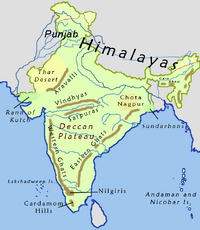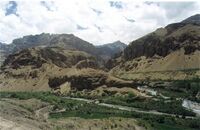Vindhya Range
| Authors: Laxman Burdak, IFS (R) & Dayanand Deswal |


Vindhya Range (विंध्यपर्वत) is a complex, discontinuous chain of mountain ridges, hill ranges, highlands and plateau escarpments in west-central India. Technically, the Vindhyas do not form a single mountain range in the geological sense.
Variants
- Vindhya विंध्य = Vindhyachala Parvata विंध्याचल पर्वत (AS, p.848)
- Vindhyachala Parvata (विंध्याचल पर्वत) (AS, p.848)
- Vindhya range/Vindhya Range
- Vindhya Parvata (विंध्यपर्वत)
Location and Extent
The exact extent of the Vindhyas is loosely defined, and historically, the term covered a number of distinct hill systems in central India, including the one that is now known as the Satpura Range. Today, the term principally refers to the escarpment that runs north of and roughly parallel to the Narmada River in Madhya Pradesh, and its hilly extensions. Depending on the definition, the range extends up to Gujarat in the west, and Uttar Pradesh and Bihar in the east.
The Vindhyas have a great significance in Indian mythology and history. Several ancient texts mention the Vindhyas as the southern boundary of the Āryāvarta, the territory of the ancient Indo-Aryans. The range of these mini hills continues to be considered as the traditional boundary between Northern and Southern part of India. The former Vindhya Pradesh (विन्ध्य प्रदेश) was named after the Vindhya Range.
Etymology and names
According to the author of a commentary on Amarakosha (अमरकोश), the word Vindhya derives from the Sanskrit word "Vaindh" (वैंध - to obstruct). According to another theory, the name "Vindhya" means "hunter" in Sanskrit, and may refer to the adivasi (tribal) hunter-gatherers inhabiting the region.
The Vindhya range is also known as Vindhyachala (विंध्याचल) or Vindhyachal; the suffix achala or achal (Hindi: अचल) refers to a mountain. In the Mahabharata, the range is also referred to as Vindhyapadaparvata (विन्ध्यापर्वत). The Greek geographer Ptolemy called the range Vindius or Ouindion, describing it as the source of Namados (Narmada) and Nanagouna (Tapti) rivers. The Daksinaparvata (दक्षिणपर्वत) ("Southern Mountain") mentioned in the Kaushitaki Upanishad is also identified with the Vindhyas.
Rivers in Vindhyas
Several tributaries of the Ganga-Yamuna system originate from the Vindhyas. These include Chambal, Betwa, Dhasan, Ken, Tamsa, Kali Sindh and Parbati. The northern slopes of the Vindhyas are drained by these rivers.
Narmada and Son rivers drain the southern slopes of the Vindhyas. Both these rivers rise in the Maikal hills, which are now defined as an extension of the Satpuras, although several older texts use the term Vindhyas to cover them.
In Mahabharata
Vindhya (विन्ध्य) (Mountain) in Mahabharata (VI.10.10), (IX.44.13),(IX.44.45), (XIII.26.46),
Anusasana Parva/Book XIII Chapter 26 mentions the sacred waters on the earth. Vindhya (विन्ध्य) (Mountain) in Mahabharata (VI.10.10), (IX.44.13),(IX.44.45), (XIII.26.46).[1]..... By exposing oneself to heat in the tirtha called Vindhya, a person devoted to truth and endued with compassion for all creatures should then betake himself to austere penances, actuated by humility. By so doing, he is sure to attain to ascetic success in course of a single month.
विंध्य = विंध्याचल पर्वत
विंध्य = विंध्याचल पर्वत (AS, p.848): विजयेन्द्र कुमार माथुर[2] ने लेख किया है .....विंध्य शब्द की व्युत्पत्ति 'विध्' धातु (बेधन करना) से कही जाती है। भूमि को बेध कर यह पर्वतमाला भारत के मध्य में स्थित है। यही मूल कल्पना इस नाम में निहित जान पड़ती है। विंध्य की गणना सप्तकुल पर्वतों में है। (दे. कुलपर्वत) विंध्य का नाम पूर्व वैदिक साहित्य में नहीं है।
वाल्मीकि रामायण, किष्किंधा काण्ड 60,4-6 में विंध्य का उल्लेख संपाती नामक गृध्रराज ने इस प्रकार किया है- ‘अस्य विंधस्य शिखरे पतितोऽस्मि पुरानद्य सूर्यतापपरीतांगो निदग्धः सूर्यरश्मिभिः, ततस्तु सागराशैलान्नदीः सर्वाः सरांसि च, वनानि च प्रदेशांश्च निरीक्ष्य मतिरागता हृष्टपक्षिगणाकीर्णः कंदरोदरकूटवान् दक्षिणस्योदधेस्तीरे विंध्योऽयमिति निश्चितः।'
महाभारत, भीष्मपर्व 9, 11 में विंध्य को कुलपर्वतों की श्रेणी में परिगणित किया गया है। 'श्रीमद्भागवत' 5,19,16 मेंं भी विंध्य का नामोल्लेख है- ‘वारिधारो विंध्याः शुक्तिमानृक्षगिरि पारियात्रो द्रोणश्चित्रकूटो गोवर्धनो रैवतकः।'
कालिदास ने कुश की राजधानी कुशावती को विंध्य के दक्षिण में बताया है। कुशावती को छोड़कर अयोध्या वापिस आते समय कुश ने विंध्य को पार किया था- ‘व्यलंङ्घयद्विन्ध्यमुपायनानि पश्यन्मुलिन्दैरुपपादितानि।' रघुवंश 16,32
विष्णुपुराण 3,11 में नर्मदा और सुरसा आदि नदियों को विंध्य पर्वत से उद्भूत बताया गया है- ‘नर्मदा सुरसाद्याश्च नद्यो विंध्याद्विनिर्गताः।' पुराणों के प्रसिद्ध अध्येता पार्जिटर के अनुसार (दे.जर्नल ऑव दि रायल एशियाटिक सोसायटी 1894, पृ. 258) मार्कण्डेय पुराण 57 में जिन नदियों और पर्वतों के नाम हैं, उनके परीक्षण से सूचित होता है कि प्राचीन काल में विंध्य, वर्तमान विंध्याचल के पूर्वी भाग का ही नाम था, जिसका विस्तार नर्मदा के उत्तर की ओर भूपाल से लेकर दक्षिण बिहार तक था। इसके पश्चिमी भाग और अरावली की
[p.849]: पहाड़ियों का संयुक्त नाम पारिपात्र (=पारियात्र) था। पौराणिक कथाओं से सूचित होता है कि विंध्याचल को पार करके [Agastya|अगत्स्य]] ऋषि सर्वप्रथम दक्षिण दिशा गए थे और वहां जाकर उन्होंने आर्य संस्कृति का प्रचार किया था। (दे. ब्रह्मपुराण-‘अगस्तयो दक्षिणमाशामाश्रितय नभसि स्थितः, वरुणस्यात्मजो योगी विंध्यवातापिमर्दनः) अगस्त्य शब्द की उत्पत्ति भी व्याख्याकारों में इसी कथा के प्रसंग में इस प्रकार की है-- 'अगं विंध्यपर्वतं स्तयायति अगस्त्य:' अर्थात अग या (विंध्य) पर्वत को निरुद्ध करने वाला. (दे. अकतेश्वर).
विन्ध्याचल पर्वत परिचय
विन्ध्याचल पर्वत पहाड़ियों की टूटी-फूटी श्रृंखला, जो भारत की मध्यवर्ती उच्चभूमि का दक्षिणी कगार बनाती है। पश्चिम में गुजरात राज्य से लगभग 1,086 कि.मी. तक विस्तृत यह श्रेणी मध्य प्रदेश को पार कर वाराणसी (बनारस) की गंगा नदी घाटी से मिलती है। ये पर्वत मालवा पठार का दक्षिणी छोर बनाते हैं और इसके बाद दो शाखाओं में बंट जाते हैं – कैमूर श्रेणी, जो सोन नदी के उत्तर से पश्चिमी बिहार राज्य तक फैली है तथा दक्षिणी शाखा, जो सोन और नर्मदा नदी के ऊपरी क्षेत्र के बीच मैकाल श्रेणी (या अमरकंटक पठार) में सतपुड़ा पर्वतश्रेणी से मिलती है।
नदियाँ: 450 मीटर से 1100 मीटर ऊँचाई पर विंध्य श्रेणी से गंगा-यमुना प्रणाली की मुख्य दक्षिणी सहायक नदियाँ निकलती हैं, जिनमें चंबल, बेतवा, केन और टोन्स शामिल हैं। अपनी समतलीय बलुआ पत्थर संरचना के कारण ये पर्वत समतल शिखर युक्त और पठार जैसे लगते हैं। दूसरी शताब्दी के यूनानी भूगोलवेत्ता टॉल्मी ने इस श्रेणी को उत्तरी और प्राय:द्वीप भारत के बीच सीमा माना था। इसके अधिकांश पर्वत चूना पत्थर से निर्मित हैं। इन श्रेणियों में बहुमूल्य हीरे युक्त एक भ्रंशीय पर्वत भी हैं।
अकतेश्वर
अकतेश्वर (AS, p.8) नर्मदा नदी के उत्तर तट पर स्थित एक स्थान है। कहा जाता है कि यह वही स्थान है जहां दक्षिण दिशा की ओर जाते हुए महर्षि अगस्त्य ने विंध्याचल को बढ़ने से रोक दिया था। महाभारत वन पर्व 104 तथा अनेक पुराणों में इस कथा का उल्लेख है। महर्षि अगस्त्य के नाम से एक प्राचीन शिवमंदिर भी यहां स्थित है। (दे. विंध्य) [3]
कुशावती
विजयेन्द्र कुमार माथुर[4] ने लेख किया है ...1. कुशावती (AS, p.213): वाल्मीकि रामायण, उत्तरकाण्ड 108,4 से विदित होता है कि स्वर्गारोहण के पूर्व रामचंद्र जी ने अपने ज्येष्ठ पुत्र को कुशावती नगरी का राजा बनाया था-- 'कुशस्य नगरी रम्या विंध्यपर्वत रोधसि, कुशावतीति नाम्ना साकृता रामेण धीमता'. उत्तरकांड 107, 17 से यह भी सूचित होता है कि, 'कोसलेषु कुशं वीरमुत्तरेषु तथा लवम्' अर्थात रामचंद्र जी ने दक्षिण कौशल में कुश और उत्तर कौशल में लव का राज्याभिषेक किया था. कुशावती विंध्यपर्वत के अंचल में बसी हुई थी और दक्षिण कोसल या वर्तमान रायपुर (बिलासपुर क्षेत्र छत्तीसगढ़) में स्थित होगी. जैसा की उपयुक्त उत्तर कांड 108,4 सेवा से सूचित होता है
स्वयं रामचंद्र जी ने यह नगरी कुश के लिए बनाई थी. कालिदास ने भी रघुवंश 15,97 में कुश का, कुशावती का राजा बनाए जाने का उल्लेख किया है--'स निवेश कुशावत्यां रिपुनागांकुशं कुशम्'. रघुवंश सर्ग 16 से ज्ञात होता है कि कुश ने कुशावती में कुछ समय पर्यंत राज करने के पश्चात अयोध्या की इष्ट देवी के स्वप्न में आदेश देने के फलस्वरूप उजाड़ अयोध्या को पुनः बसाकर वहां अपनी राजधानी बनाई थी. कुशावती से ससैन्य अयोध्या आते समय कुश को विंध्याचल पार करना पड़ा था-- 'व्यलंङघयद्विन्ध्यमुपायनानि पश्यन्पुलिंदैरूपपादितानि' रघुवंश 16,32. विंध्य के पश्चात कुश की सेना ने गंगा को भी हाथियों के सेतु द्वारा पार किया था, 'तीर्थे तदीये गजसेतुबंधात्प्रतीपगामुत्तर-तोअस्य गंगाम, अयत्नबालव्यजनीबभूवुर्हंसानभोलंघनलोलपक्षा:...' रघुवंश 16,33 अर्थात जिस समय कुश, पश्चिम वाहिनी गंगा को गज सेतु द्वारा पार कर रहे थे, आकाश में उड़ते हुए चंचल पक्षों वाले हंसों की श्रेणियां उन (कुश) के [p.214]: ऊपर डोलती हुई चंवर के समान जान पड़ती थीं. यह स्थान जहां कुश ने गंगा को पार किया था चुनार (जिला मिर्जापुर उत्तर प्रदेश) के निकट हो सकता है क्योंकि इस स्थान पर वास्तव में गंगा एकाएक उत्तर पश्चिम की ओर मुड़ कर बहती है और काशी में पहुंचकर फिर से सीधी बहने लगती है.
External Links
References
- ↑ विन्ध्ये संताप्य चात्मानं सत्यसंधस तव अहिंसकः, षण मासं पदम आस्थाय मासेनैकेन शुध्यति (XIII.26.46)
- ↑ Aitihasik Sthanavali by Vijayendra Kumar Mathur, p.848
- ↑ Aitihasik Sthanavali by Vijayendra Kumar Mathur, p.8
- ↑ Aitihasik Sthanavali by Vijayendra Kumar Mathur, p.213-214

